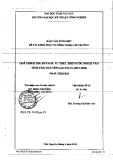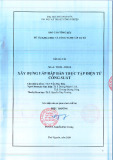
BioMed Central
Page 1 of 10
(page number not for citation purposes)
Journal of Translational Medicine
Open Access
Research
Human fallopian tube: a new source of multipotent adult
mesenchymal stem cells discarded in surgical procedures
Tatiana Jazedje1, Paulo M Perin2, Carlos E Czeresnia3, Mariangela Maluf2,
Silvio Halpern2, Mariane Secco1, Daniela F Bueno1, Natassia M Vieira1,
Eder Zucconi1 and Mayana Zatz*1
Address: 1Human Genome Research Center, Biosciences Institute, University of São Paulo, Brazil Rua do Matão, n° 106, Cidade Universitária São
Paulo SP, CEP: 05508-090, Brazil, 2CEERH Specialized Center for Human Reproduction, São Paulo, Brazil Rua Mato Grosso, n° 306 19° andar,
Higienópolis São Paulo SP, CEP: 01239-040, Brazil and 3Celula Mater, São Paulo, Brazil Al. Gabriel Monteiro da Silva, n° 802 São Paulo SP, CEP:
01442-000, Brazil
Email: Tatiana Jazedje - tatiana@ib.usp.br; Paulo M Perin - paulo@ceerh.com.br; Carlos E Czeresnia - cec@celulamater.com.br;
Mariangela Maluf - mariangela@ceerh.com.br; Silvio Halpern - halpern@osite.com.br; Mariane Secco - marianesecco@usp.br;
Daniela F Bueno - dbueno@usp.br; Natassia M Vieira - natassia@usp.br; Eder Zucconi - ezucconi@usp.br; Mayana Zatz* - mayazatz@usp.br
* Corresponding author
Abstract
Background: The possibility of using stem cells for regenerative medicine has opened a new field
of investigation. The search for sources to obtain multipotent stem cells from discarded tissues or
through non-invasive procedures is of great interest. It has been shown that mesenchymal stem
cells (MSCs) obtained from umbilical cords, dental pulp and adipose tissue, which are all biological
discards, are able to differentiate into muscle, fat, bone and cartilage cell lineages. The aim of this
study was to isolate, expand, characterize and assess the differentiation potential of MSCs from
human fallopian tubes (hFTs).
Methods: Lineages of hFTs were expanded, had their karyotype analyzed, were characterized by
flow cytometry and underwent in vitro adipogenic, chondrogenic, osteogenic, and myogenic
differentiation.
Results: Here we show for the first time that hFTs, which are discarded after some gynecological
procedures, are a rich additional source of MSCs, which we designated as human tube MSCs
(htMSCs).
Conclusion: Human tube MSCs can be easily isolated, expanded in vitro, present a mesenchymal
profile and are able to differentiate into muscle, fat, cartilage and bone in vitro.
Background
Adult mesenchymal stem cells (MSCs) are typically
defined as undifferentiated multipotent cells endowed
with the capacity for self-renewal and the potential to dif-
ferentiate into several distinct cell lineages [1]. These pro-
genitor cells which constitute a reservoir found within the
connective tissue of most organs are involved in the main-
tenance and repair of tissues throughout the postnatal life
of an individual. Although functionally heterogeneous,
MSC populations isolated from different tissues such as
Published: 18 June 2009
Journal of Translational Medicine 2009, 7:46 doi:10.1186/1479-5876-7-46
Received: 20 March 2009
Accepted: 18 June 2009
This article is available from: http://www.translational-medicine.com/content/7/1/46
© 2009 Jazedje et al; licensee BioMed Central Ltd.
This is an Open Access article distributed under the terms of the Creative Commons Attribution License (http://creativecommons.org/licenses/by/2.0),
which permits unrestricted use, distribution, and reproduction in any medium, provided the original work is properly cited.






























